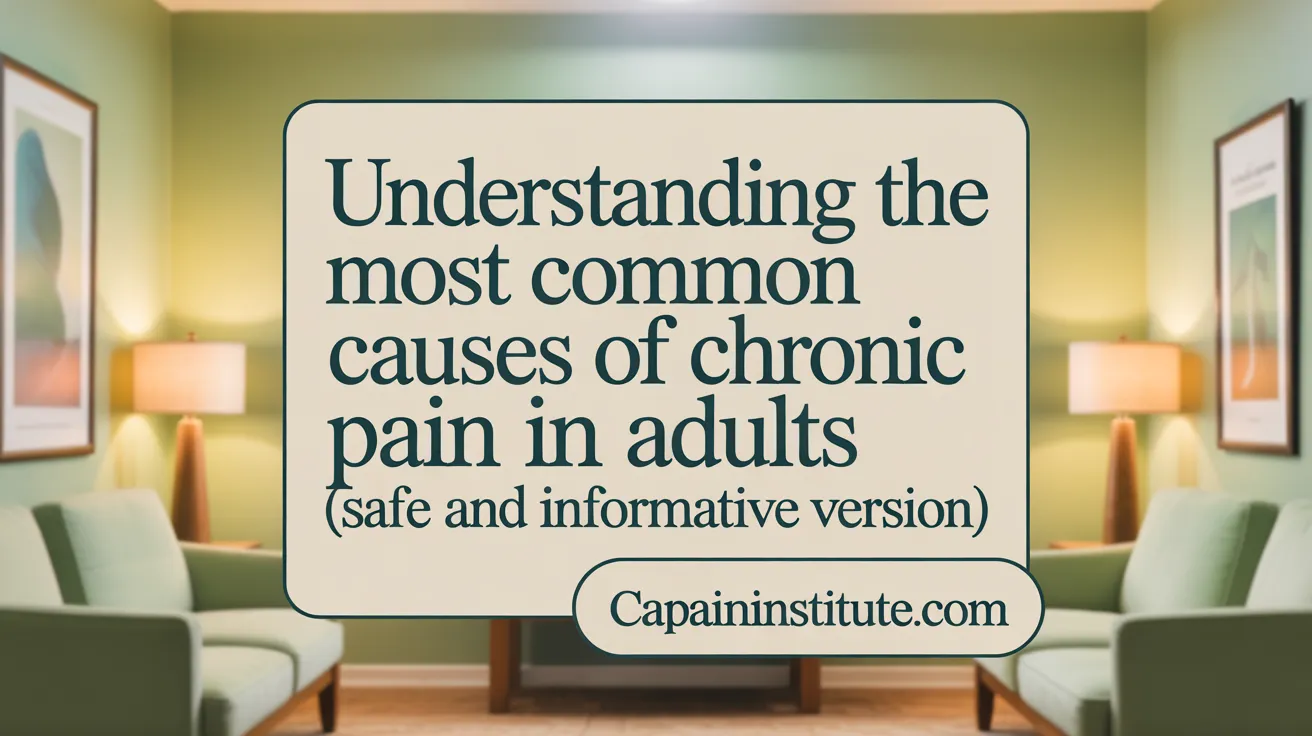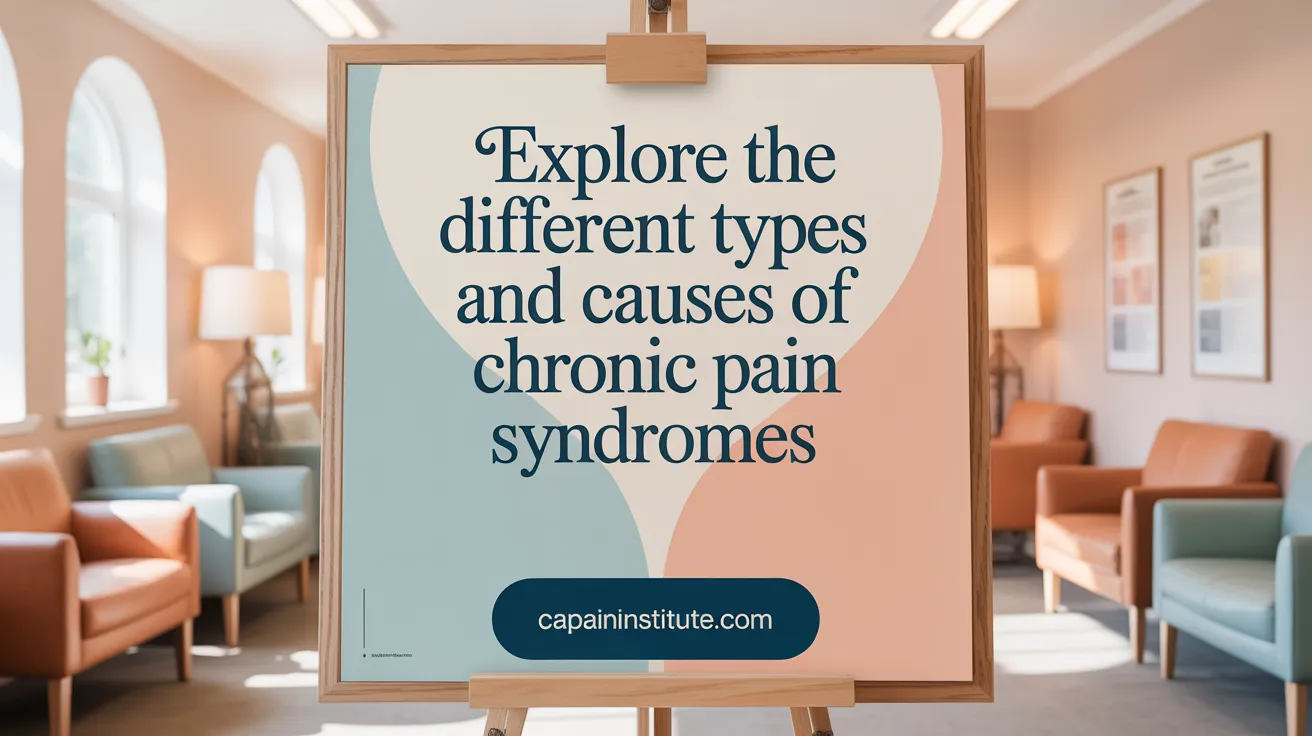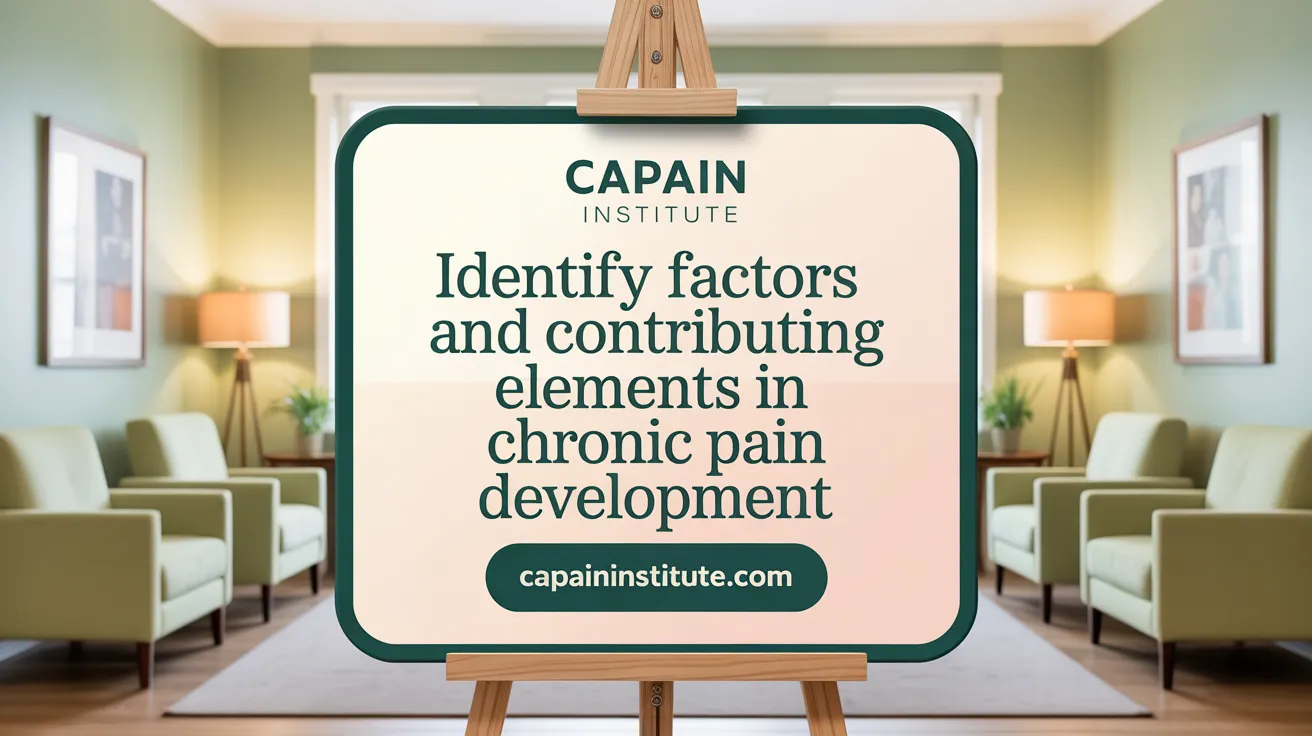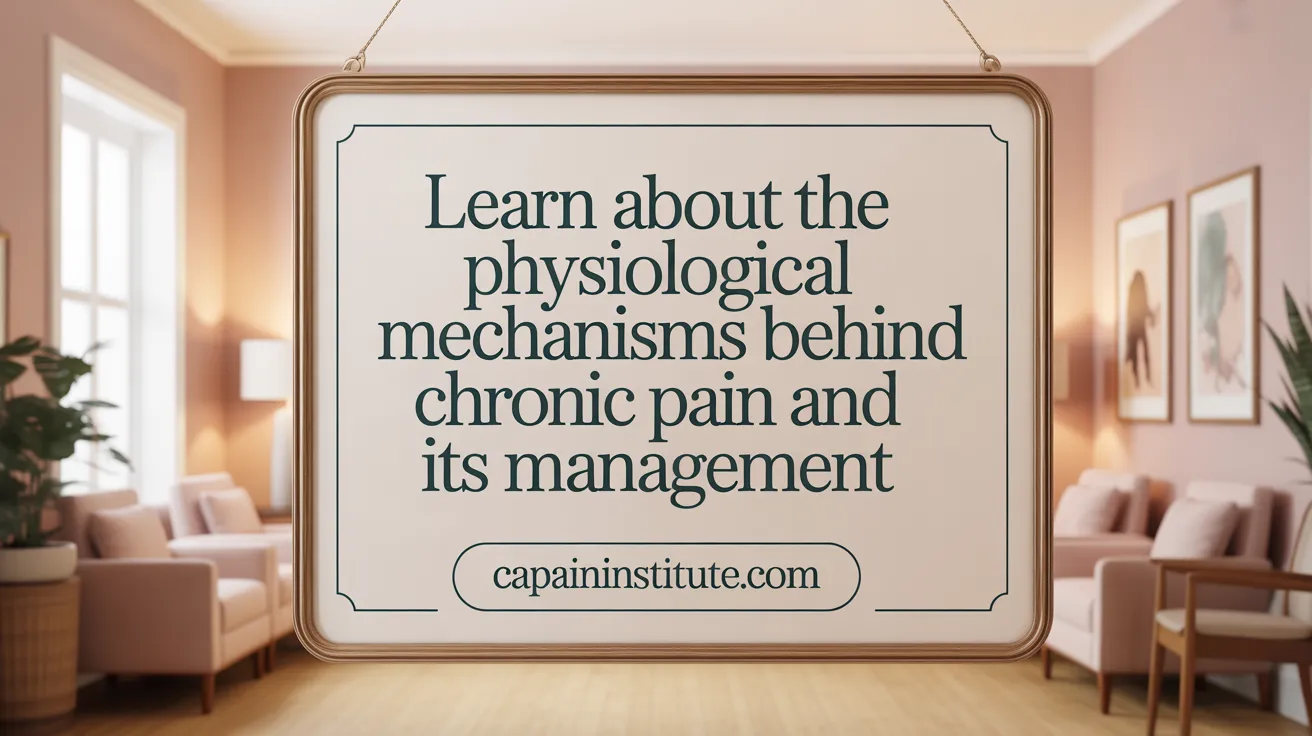Understanding Chronic Pain: A Widespread Health Challenge
Chronic pain is a prevalent and debilitating condition affecting millions of adults worldwide. Defined as pain lasting more than three months, it encompasses a variety of symptoms and causes that impact physical and mental well-being. This article explores the common medical conditions that cause chronic pain, the types and mechanisms behind it, associated risk factors, symptoms, and the latest approaches to managing this multifaceted health issue, highlighting its significant public health burden.
<!-- VIDEO:eyJsaW5rIjoiaHR0cHM6Ly93d3cueW91dHViZS5jb20vd2F0Y2g/dj1NSDVVeGlzWW05SSIsImltYWdlVXJsIjoiZGF0YTppbWFnZS9qcGVnO2Jhc2U2NCwvOWovNEFBUVNrWkpSZ0FCQVFBQUFRQUJBQUQvMndDRUFBa0dCd2dIQmdrSUJ3Z0tDZ2tMRFJZUERRd01EUnNVRlJBV0lCMGlJaUFkSHg4a0tEUXNKQ1l4Sng4ZkxUMHRNVFUzT2pvNkl5cy9SRDg0UXpRNU9qY0JDZ29LRFF3TkdnOFBHamNsSHlVM056YzNOemMzTnpjM056YzNOemMzTnpjM056YzNOemMzTnpjM056YzNOemMzTnpjM056YzNOemMzTnpjM056YzNOLy9BQUJFSUFGTUFsQU1CSWdBQ0VRRURFUUgveEFBY0FBQUNBZ01CQVFBQUFBQUFBQUFBQUFBRkJnQUVBUU1IQWdqL3hBQkxFQUFDQVFNQ0F3VUVCUWdGQ1FrQUFBQUJBZ01FQlJFQUlRWVNNUk1pUVZGaEZIR0JrUWNWTXFHeEl6VkNVbFNUd2RFV1luS2lzME4xZ3BLeXdzUGg4Q1V6TmpkVFZXVnpkUC9FQUJrQkFBSURBUUFBQUFBQUFBQUFBQUFBQUFBQ0FRTUVCZi9FQUNRUkFBSUNBUVFDQWdNQkFBQUFBQUFBQUFBQkFoRURFaUVpTVZGaEUwRUVrYUVGLzlvQURBTUJBQUlSQXhFQVB3RHVCT05ES3E3UmhlV2t4Sy82Mk80UGo0L0Q3dGJyeTNMYjVCK3VWVEhtQ1FEOTJkTE53TWoyK3A5bXdaZXpZTHpkTTRPa2xLdGl5RU5XN0NsTHhERVZra21raGxoVFpucDkrUStSR1Q0YUpVdDBvYXVKSktlcmhkWE9GdzR5VDVZNjY0M3dlMHdxRm82V1hGTlZSTWVSdWc5Y0RibXdwMzlmVFRsOUhNakQ2em9VazVId0dSc1p3ZHdUNi9vNlQ1R3BxSm9sK012aWxOZHF2MHc5L1NsUHlnTkZJcnJHckxHeElhVm1WU0ZRWTd4eTJEMDhEdm5WaWo0Z1N0cU95cDZXUWd5Qk1zd1VyM2VZbGxPNHhqSGp2dDF6ak5QWWhGQ3NUMTlYTUVDS3BrbGI3S3NUZ2dFQTVVOHAyM3huV3VLdzFjYVF4aTgxVEpGeTk1dDNmQWJZbk9NRXR2dG5BQXp0cTh4aDNWVzRSelNVN2V5eUZKbDd5K1RlaDkrcktnZ2JuSjFVdXRRSUtWZ3lTTUpNcCtUeGtaQjMzSTBzcXJjbFhld0JGM2thRlp2YThSazQ1bUlBejVhMjJ5OUdPdGFHc3FJM2htWUNKK1ljeVAwNVQ2SHc4dndCbFhpaTdLT25sWituT2k0VnY3V1NOL1VIYnoxNHJZNm1vaWlkWnF5a21pRzdxVTdOL1BuVnRzZkkrV3NNY2tvdnMzdkhHU3FoOGxxNElwT3lkeDJtQTNJdTdFZWVCdjRIVmFlOVVNRlRGVFN5TXMweUY0NHpHM00yRGpBR001OVBJRStCMHFRVlUxTXFUTHl3c1R5RmtmbHl2bmdqcG53OWZteTExREpYVzFGUm9oVnQyUk5RWWdTTUhjanlJQmJIVEdkYThjOVpqbmpjT3paVTM2MzBweE5KSVBNaUYyQTczTHVRTURmYlJHTmc2S3dCQUl6Z2pCK1dsbExaZFloTEgyTnVsaGJta0NsTUVPVHNQTGJ6eHZqd08rbWFOVlJBcUtGVlJnQURBQTFZVm5yU2R4cnhuOVF6TFJVRVVjMWN5aDJNbWVTSUhwa0RjaytXUjUrOXhPdVFmU2ZSdFQ4VEdvSjVrcVlsWWYxU0J5a2ZjRDhUcUc2UTBWYm91MlA2UmJnTGhGSGRvNmVTbGtZS3p4b1VhUEo2OWNFRHk2L2hycVExODRPQ3lNb0c1QkExOUIyaVdTYTIwOGtwQmNydXdHQTJOc2ozOWZqcFlTVWl6TGlsanExUmMxTlRVMDVTQjc5TUIyTWZndVpHOU5zRDhUOHREREFZSGVKOXpuTEErQllBa2ZNblY2N1I5dGRFaC84QVVTTlQ3aXpaKzdPcTFZL2FWdFE0NkdRZ2ZEYitHcXBGK1A2UUh0Vm9ndG5ieUNPSXMwcnVoVkFDaUhHRis3Vk94T3RtNDJraGtjTEU2TXJNeHdBQ29mUHpHanNnTEl3SFVnalErOFVTTnhqYXFuc3c4RldrWklaY2drYmIvRGwxVTEwMTVObUtkNjR5KzR2K2JoQ3ZwcDRoWFZkTmNIZVBrbGxZb0NBaDM1Y01EZ2tBL2R1Y0FBRDVwQTg3UXlYU3NwZ2pZSGF4TnVIS2Judzd2TUZQZ055ZFBmSXZMeTRITGpHTWJZMEM0M3VsUlpPR3FtNFVLUXZVbzBhUjlzcEs1ZVJVeVFNZnJaK0d0YU9ZZWJkYmFxVDJhckZ4TWtaL0tLNTVzbFdLa0RITmo3STVkODlkR0s2a0ZaR0VhUmt3YzVVRCtPbFdxcitMdUg0RFczS0MyWFMzUWpNNjIrTjRab2tIVmxWaVE0QTN4a0hUVkRYVTA5dld2aW1WcVY0dTJXVUhZb1JuUHkxRFZyY2xPbmFLWDFJbjdUTG4zTC9MV2lhd05LcFExS2xENXhISStJYlZiNlB1S1A2V1dBM0I0a2hsV2Q0M2pYT0FOaXZYelJsUHgxYjRndTA5dHVWaXA0RmpLVjljWUpTNE9RdlpPMjNybFJxdjRZZUIvbG41TEZGWTZPa1lTRU5QS0RrU1RIbUsrN3kvSFJQU2p4THhjYkR4Zlk3WlVSeCt3M0JKQkxNYzgwVDh5cWh6MHhsc0hQbU5OdlVhZFJTNkViYjdLMWNLa3JFYVVLU0pBWEJibHl1RHNEZytPUGhuU3JOWFhDbHJ6QlYzbUppdll3T2lMeU4yakRteXBLa1pPQU1Id0o4Y2FNOEhYZWErOFB3M0NwampqbGtrbFVySG5BQ3lNbzYraWpSUjZXbmNzend4c1d6a3NvT2NnQTUrQUExSkF2VWM5M2VCVEpYMDFTd1RsYzB5a2M1VisrUU9VNHhrTDQrZTJkZU9MYmRTMzYzU1JTeHpRelE4aGpuTVpBeVd4Z1p4bng4QjE5ZE1VTkhTVWhNa0VFVVJDNExLb0czL0FGK0dsZXQ0aVdyRVZSVDJ1S1NCemlDYXNxREVaQWVqSUZWamcrWnhwWmRVUEMxSk5ITjdQYTJlNlJKVXNqS3I1NUZ6MzhiZ0UrcEdPbXU0VzVCSFEwNkJ3NEVhOTRkRHQxMG1XbWtzZFRWMHF6MjZvdDFYTGg0RDJ4ZU9RZ2MyRmJ6eHZnZ0hyanBwMHBLZGFXSVJJN01nUGREZm9qeTkycXNHTjQ3VE4zK2grUkhOSk5YdDVMR3BxYW1yem5BR3ZxRmd2MU1YSURNWTBRSDlMSllmeFB5ME9FOFcvTk5HR0pKYkxEcWV1bW1XbGhsbWlta1hNa0pKUnNrRVpHRHJiZ2FSeHNlTTZFNkNxaWxpUnk2S1dHY0ZodHF3OVNwcWJYQVRsaERFeUFlckRQNExwcHhyVTlORTg4YzdwelNSZ2hDVDluUFhiK09oUW9sNUxOMmxQNlUvL0JOWi93RGRUZjQ4ZW16U2w5S3FoK0JxOVRuQmtnQndjZjVaTldMc3JDL0V0N29MRmE1YW00eXFGWlNrY1hWNTNJMlJGNnNUNURTZldVMWJhUG9udDFqa3pIY3E2T0czS2czS05LY01QOUZTM3kwelduZ3l3V3F0OXVwcUhuclJzS21wbGVlUmY3TE9TVitHTkJ1S2FIK2t2R2R1czN0VlZUUVc2bGV1bGxwSk9TUlpHUFp4Z040YmRwb1FHNnl3UjJMajZ1dGtJNUtXNDIrR3BnWHdEdy9rbkE5ZVhzejhOV09NL3dBOWNJLzUyUDhBZ1M2QjN6aDhjTFhHeDhRSmQ3dlhDbXIwZ25GZlZtVlVobS9Kc1JrYmQ0b2ZoNmFPY2FmbmZoSS8vTWY4Q1hRQlI0dHRkUGV1TktHMjFZekRVMmFzakpIVlR6dzRZZW9PQ1Bkb3Z3UGRLaXZ0TFV0eVAvYWx0a05KVy8xblhvL3VaY044ZFZybi93Q1pWaTliYldEKzlEclRmaC9SM2kyaXZ5ZDJodVBKUVhFRG9yRS9rWlQ3aVNoUGt3MEFWdUNZNnliNk9JRXQwbloxTFRTOHJEcUI3UTNOamNiOHVmRWU4YUxSVTNFdk9XZXFwRXlaRzVjbGh2a0tOMTJ4a0UrZktCamNuUXpnS1dwZytqK2pha2pEeTl0TnNWTEFEdG56c04vbHErdDlyNFVsa2tocHBFWVNUSVBhRURSeFpZS1NNNEl5QmtnK1BVbllnRXVvdU5Md3BjNUxuV1Jtb1duYkRRZ1lZOW1xNHdSdGw4N0R6RzQ2YVE0cnBTMTVoOXFSSVpsNVVra2txU0ZkVHNTdVZPTWJIbHo4OGFkTHE5YmVlR2JyVFZsQ0dsV21KUllEemZsbHl3WHVrOTRkemJ6QjZqWExxaUdhRHV6d3l4TVJrQ1NNcm41NnB5TnFTWmRqaEdjV21Oa04yN1dqZ29LbnZWWnFGV0FvZVlwS3NnQUI2RVlJOWRzK0d1cURYSlBvNW9JcXZpdVdXWEI5azdXVlI1dHpZQitITWZqalhYTk5BWEo5SW1wcWFtbkt5YTAxVlF0TkMwcmdrRG9GNmtrNEFIdkpHZ3ZHRjFxclRTd3owaGo1Z3habGNNZWNEQXhzcDIzNjVYZkc1M0d0eHVyelE4azFtclpGWVlaVmpVcWY5WWpJOTQxRGtrNkpvM1YxN2dvT1lWRWNnS1FpVjhGZTZDU0FPdTV5TWJlbXE5THhQUTFVNWhpU1l5TDlwZVVaRzJTTVp6a2VYWHlCMWxhN0VYWnJZSzRSNDVlWHM0c1k4c2MzVFdwcDRPVUszRGRUeXIwSHM4UkEvdmFOU0NnclNWOFZVaUZjcXo1N2pFWkdPb09DUm5wdG5RZmoyaVc1OE95Mi93QnNwcVY1cFlXVjZoK1ZTRWtWMkh5VTZ5MVM0YW5OTGFhMkNPR1F5TWdnVHZaVWpwemRkK3VyaVZFZHhsU0twdEZTRjN3OVRDcFZkdmVkUnE4QWw1Ti8xeGJQL2NLVDk4djg5QTdGN0pSM20rWE90dWRBMHRmVUlJZVNkVHl3SWdDQSt1UzUrT2ovQU5WMi93RFlLWDl5djh0WStyTGQrdzB2N2xmNWFPWTNEMkNPSy9xdS9jT1hLMUc0MFlhcXAyUkdhWmNLK082VHY0TmcvRFZHNDR1SzhNeTFGenRvcWJmVkpVVm1La0VFaUYxYms4Kzh3NjQyMHkvVmR1L1lhWDl5djh0VDZydDM3RFMvdVYvbG81aHc5Z090TkpQeGRhN3NseW9mWjZXa3FJWkFaeHpGbk1aR0I1ZDA1MWV2TXRsdkZxcXJkVjE5S1lhbUl4dGlaY2pQUWpmcUR2OEFEWG02UFo3WkpFazl0aVl5cXpEczZkVGdLVkJ6OFdHcWYxcHc3a3FMZkV6aVl3bEZwMEpEQUVucDF4eW5wdm81aHc5bnI2UHFENnM0VXBiVFBWMDFUUFRoMWxhbms1bFBNN0VIejNCMFFxT0hxR3BpN0twTThzUUtOeU5KdGxQczlOOXZ2enZuVk9DK1dlbUk5aWdDQ1NkWUMwVWFvQ3h5Um5wNERQdUk4OVp1WEVFTS9EbDBxcmRJUkxEUnZKR3hHTzhRNFEvTmMrNGpUYjlzV2xld3YzN2k2aXM3MU5IYUU5c3FDeEUwOHpuczBiSk9CakJKQko2WXg1N1kwaDNPNzFsMW03ZXJrZWRsQkNsaVFxRHJnWjMvQUIxVENoank0L0pwc0I1bld4L3NON2pyTEtia2JvNG9RN1c0UW82dXVzRjJhb3BwVldwVnN0K2tyQndHS256RzQ4dW11Z1dQNlFxV3NtanBybFRta2tjOG9sVnVhTFBoazdGYy9MMTF6NjlmbldwSGtWSHlSUi9EVkVnRUVNTWc5UWZIVXFiVEVlT01rZlFvMU5DZUZLbVNyNGJ0czB6RnBUVHFIWTlXSTJKKzdVMXBNYjJOMTJpU2VNTEdJWHJVRFBTcksyd2ZHelk4Y2RlaHhxblZtK0dPRnFkVTdVUk9HVlNwamFUdTRMWjNDL2IrenZ1TTZIOFpOUDIxR3FSQmxETHl1c1dKRll0K2cvT0RrajlFS2ZVZ2FyengzeHFpVG5lNURjY2dWZ05zRDlRY3ZYUGpwZFhMVFFQWldHVk4zYU1KaVJIQVU5cEoyWGU2NUJ4bkhoMEhRYXdndXJVOFZMN1pGN1hGbnRwbFVkOFlQS2NFSDB6b0RMVDhSNWo3RDZ5NWVjZHJtb1hkUFRPK2M0NmI5ZFpqb3IyanZKRERjUTBtT2R1M2pCYkhUT2Q5TlltcjBGREh4T3p1eXlRS29lZmxERmR3Y0NQb053T3U1QjhQZVN0aHVIYXlpdUI1TUx5RWxSdjQ3TDg4ays0YVdJNmZpUU0vYi9XSmZtUEp5MUM0NVBEcHRuNzlFTExEZVV1Y1JxUldpbnczYWR2S3JMMDIrT2NkTkZrcDcwTldsNlJlSUlwNWVYRXNieVN0R1l5dmRIK1RVaHNiZUp4NmV1bUhRcTlYV3B0OGtFZExiNUtzeTUreVdBWEdQSlQ1K09OQXhUNWIvTEs1Vm1nVlZsS2gxaVlOMDdNYmJnOVNTZHM5TnRhbUhFY0x6TzdLOU9rSzh2THlHUm56bHU3akdNREEzemh1aEkxNjl0NG1xUDhBdWJiQlRnL3BTa0gvQUhzL2RyZkZSWDZVWnFickZBZkZZWVF3K1pBSTFMMkF0MDlaRFhSeE9WaGxnblhsQlU4d0RZM1E1SHA2ZE9taFV0bnZQY1ducktSTVJoZTBFSVZsYk83WUEzMkxBRGJyblN4RHhiYUtDNlR4TmRXYVB0bGtaa2dlUnBNYzJTT1VFRWxpTi9KZEZaL3BNdFNiUVVOeG0vcmRtcUQ3Mno5MmsxcGRqckhOOUlKVDBOM05iS2VlanpMRGlQQXdjRHJ6SGwzQnlveHQ0a2VXdEgwaFNRMG5ERXVJNGtubmFPQkdDak9NaGlBZkxsVnRMMVo5SmNzN0thVzA5bVVPVmtlVXQ0WTNIS1BQejBzWC9pRzVjUVNSL1dEeHhvbTBjYURsVUUrUXljazlNa24wMGtzcXJZdGhnbnE1YkFtSnUrbjlkR1kvTWZ6MXVmN0RlNDZKMWRsbm9iUkJYMWtEd3ZVVGNrU3lMaHV6QzV6and5VDQvcWpReHZzbjNhcGFvMGF0VnN2M3c1dk5iNlRNUGx0L0RRNEU5czR3Y0JCN3VwLzVhSTN2ODgxMy93Q2gvd0RhT2l2RG5EazNFTnRJcFpZbzVJS3hoSXo1MlJvMDhCMU9WNmUvVTFib1Z5U1NiT2djQXlyTHdsUUZUOWtPaDk0ZGgvRFUxYjRic2lXRzNleVIxRXMrWE1oWndCZ2tEWUR3RzJmSHFkWjFwVDJNVXFiWmZlbWdrbmlxSGhScG9nUkhJUmtvRDF3ZkRPdCtwcWFrZ21wcWFtZ0NhbXBxYUFKckI2alUxTkFHZFlQUTZtcG9BcDFWdG9LeEFsWFEwMDZodVlMTENyQUh6M0hYVkdtNFJzRkxPSjRiWEFISDJRMldWZmNwT0I4QnJHcG9wQW02TGM5a3RFNXpQYTZHUStiMHlIOFJyM1NXdTNVUkxVVkJTVTdlY01Lb2Z1R3BxYUtDMmVMclpyZmVJNDQ3bFQ5c2tiY3lEblpjSHA0RWFISndUdzZwL053UDlxYVEvaTJwcWFScFdTbTBpNmVIYk0wanpQYktWNUdPUzBrWVlrL0hSQ0dHS0JGamhqU05CMFZGQUErR3BxYWxJRzJiZFRVMU5NUWYvOWs9IiwidGl0bGUiOiJVbmRlcnN0YW5kaW5nIFRoZSBDYXVzZXMgb2YgUGFpbiBhbmQgUGFpbiBNYW5hZ2VtZW50Iiwic25pcHBldCI6IkNvbW1lbnRzIMK3IFVuZGVyc3RhbmRpbmcgdGhlIENhdXNlcyBvZiBCbG9vZCBpbiBTdG9vbCAoUmVjdGFsIEJsZWVkaW5nKSDCtyBQYWluIHwgUGF0aHdheSBhbmQgQW5hbGdlc2ljcyAoTlNBSURzLCBPcGlvaWRzLCBBbnRpZGVwcmVzc2FudHMsIGFuZCAuLi4ifQ== -->Common Medical Conditions Causing Chronic Pain in Adults

What are the common medical and health conditions that lead to chronic pain in adults?
Chronic pain in adults often stems from a range of medical and health conditions. Arthritis, including osteoarthritis and rheumatoid arthritis, is among the most prevalent causes, affecting over 50 million Americans annually. These conditions cause joint inflammation, stiffness, and persistent pain that can last a lifetime.
Back pain, especially lower back pain, is another common source. It may be caused by degenerative disc disease, spinal stenosis, herniated discs, or muscular strain. These issues can result in aching, stiffness, or radiating pain down the legs, frequently affecting mobility.
Headaches and migraines are also significant contributors. Chronic headaches, including tension-type and migraine headaches, can persist for many days each month and impact daily functioning.
Fibromyalgia involves widespread musculoskeletal pain, characterized by a dull ache, fatigue, sleep issues, and heightened sensitivity to stimuli, which can be disabling.
Nerve damage, such as diabetic neuropathy or post-shingles neuralgia, leads to neuropathic pain. Symptoms include burning, shooting sensations, numbness, tingling, and increased sensitivity.
Cancer-related pain is common in individuals with advanced disease, caused either by tumors pressing on nerves or organs or as side effects of treatments like surgery, chemotherapy, or radiation.
Inflammatory diseases, such as inflammatory bowel disease (IBD), gout, and vasculitis, can cause ongoing pain. Conditions like TMJ disorder, vulvodynia, and other systemic illnesses may also contribute.
Other causes include injuries from trauma or repetitive motions, structural abnormalities in muscles or bones, and psychological factors like depression and anxiety, which can intensify pain perception.
Overall, these conditions involve both physical and neurological components, and often coexist with mental health issues, making chronic pain management complex.
Types and Causes of Chronic Pain Syndromes

What are the different types of chronic pain syndromes and their causes?
Chronic pain syndromes are broadly categorized into primary and secondary types. Primary syndromes, such as fibromyalgia, chronic headaches, and widespread musculoskeletal pain, often occur without a clear underlying medical condition. These pain conditions are characterized by diffuse symptoms and are believed to involve central nervous system alterations, including heightened pain sensitivity.
Secondary pain syndromes are linked to identifiable health issues like arthritis, nerve injuries, cancer, or complications following surgery. For example, osteoarthritis causes joint inflammation and persistent discomfort, while nerve damage from diabetic neuropathy results in burning or shooting pain.
The origins of chronic pain are diverse and multifaceted. Neuropathic pain stems from nerve damage or dysfunction, often due to injury or illnesses like shingles or diabetes. Musculoskeletal issues involve injuries, degeneration, or repetitive strain affecting bones, muscles, and joints.
Visceral pain originates from internal organs affected by conditions such as endometriosis or irritable bowel syndrome, typically presenting as deep or cramping sensations.
Changes in the nervous system, including central sensitization, can amplify pain perception. This process involves increased responsiveness of neurons within the central nervous system, making sensations more painful even without ongoing tissue damage.
Psychological and lifestyle factors, such as stress, depression, obesity, and sedentary habits, can worsen or perpetuate chronic pain states.
Overall, chronic pain syndromes are caused by a complex interaction of physical, neurological, and psychosocial elements, making diagnosis and treatment challenging but essential for improving quality of life.
Risk and Contributing Factors in Chronic Pain Development

What are the risk factors and contributing factors associated with the development of chronic pain?
Chronic pain does not develop randomly; a combination of biological, psychological, social, and environmental factors influences its onset and persistence.
Age and gender play substantial roles. Older adults, especially those over 65, are at higher risk due to age-related conditions like arthritis and degenerative joint diseases. Women tend to report and experience more pain than men, influenced by hormonal variations and conditions like endometriosis.
Ethnic and socioeconomic disparities are evident, with non-Hispanic American Indian or Alaska Native populations and individuals experiencing socioeconomic deprivation showing higher pain prevalence, severity, and disability.
Lifestyle choices significantly contribute. Smoking and alcohol consumption are linked to increased pain intensity and dependency, while obesity amplifies strain on joints and nerves. Physical inactivity and poor sleep patterns further heighten the risk by weakening musculoskeletal health and impairing pain regulation.
Psychologically, conditions like depression and anxiety are common in those with chronic pain, creating a vicious cycle of increased pain and emotional distress. Past trauma or adverse childhood experiences also increase susceptibility, as does psychological stress, which can exacerbate muscle tension and pain perception.
Occupational factors such as manual labor, repetitive movements, and job-related stress elevate risk, especially in physically demanding or poorly controlled work environments. Environmental exposures, including poor posture and repetitive tasks in daily life or work, contribute by causing overuse injuries and musculoskeletal strain.
Prior injuries serve as a critical factor. Both acute injury and recurrent traumas can lead to nerve damage or musculoskeletal deterioration, paving the way for chronic pain. The presence of other health conditions, such as cardiovascular diseases or neurological disorders, often complicates pain management and increases the likelihood of persistent discomfort.
Understanding these interconnected factors is essential for developing effective prevention and management strategies for chronic pain. Addressing modifiable lifestyle factors, providing psychological support, and improving occupational safety can collectively reduce the risk.
| Risk Factor Category | Specific Factors | Impact on Chronic Pain Development |
|---|---|---|
| Biological | Age, gender, genetics | Higher prevalence in elderly, women, those with genetic predispositions |
| Lifestyle | Smoking, obesity, inactivity | Increase in musculoskeletal strain, inflammation |
| Psychological | Depression, trauma, stress | Amplify perception of pain, hinder recovery |
| Socioeconomic | Deprivation, manual labor | Limited access to healthcare, more physical strain |
| Environmental & Occupational | Poor ergonomics, repetitive tasks | Musculoskeletal injuries, nerve stress |
| Prior Injuries & Health Conditions | Surgery, infections, chronic illnesses | Nerve damage, ongoing inflammation |
Symptoms, Comorbid Conditions, and Impact of Chronic Pain

What symptoms and related health conditions are commonly linked to chronic pain?
Chronic pain presents with a variety of symptoms that can be both physically and emotionally distressing. Individuals often describe the pain as persistent aching, burning, shooting, throbbing, or electrical sensations that do not easily subside. Along with these sensations, affected persons may experience stiffness, soreness, and heightened sensitivity to light, sound, or touch.
In addition to the pain itself, many individuals report fatigue and sleep disturbances, such as difficulty falling asleep or waking up frequently during the night. These disruptions can further weaken their overall health and ability to function normally.
Chronic pain is deeply intertwined with mental health conditions, with depression and anxiety being particularly common. These psychiatric disorders can exacerbate perceptions of pain and create a vicious cycle that complicates treatment and management.
The health landscape of someone with chronic pain often includes other related conditions. Neuropathic pain, resulting from nerve damage, frequently coexists with nociceptive and musculoskeletal pains seen in arthritis and fibromyalgia. Chronic inflammatory diseases like rheumatoid arthritis and cancer also frequently feature in this group.
The impact extends beyond physical symptoms; chronic pain can significantly impair daily life. It leads to social withdrawal, reduced work productivity, and difficulties maintaining personal relationships. Emotional distress is common, with some individuals experiencing feelings of hopelessness, which increases the risk of suicidal thoughts.
Furthermore, the burden of living with ongoing pain often results in increased reliance on medications and healthcare resources, heightening the risk of substance misuse. Recognizing these symptoms and associated conditions underscores the importance of comprehensive, multidisciplinary approaches to managing chronic pain effectively.
Underlying Physiological Mechanisms Driving Chronic Pain

What are the underlying physiological mechanisms behind chronic pain?
Chronic pain involves complex mechanisms that extend beyond simple tissue injury or inflammation. It is driven by interactions between peripheral nerves, immune cells, and the central nervous system.
Initially, peripheral sensitization plays a significant role. This process occurs when inflammatory mediators such as cytokines, nerve growth factors, and chemokines are released at the injury site. These substances sensitize nociceptors, the nerve fibers responsible for sensing pain, making them more excitable. As a result, nociceptors may fire spontaneously or respond to lower levels of stimulus, producing persistent pain signals even after tissue healing.
At the same time, changes within the central nervous system contribute heavily to chronic pain. Neuroplasticity allows the brain and spinal cord to adapt structurally and functionally in response to ongoing pain signals. Central sensitization is a key concept here, where neurons in the spinal cord become hyper-responsive, amplifying pain perceptions. Glial cells, especially microglia and macrophages, become activated in the central nervous system, releasing additional inflammatory mediators that potentiate neuronal excitability.
Another component is the loss of inhibitory pain controls. Normally, descending pathways from the brain suppress pain signals through neurotransmitters like serotonin and norepinephrine. In chronic pain states, these inhibitory mechanisms can weaken, allowing pain signals to become unchecked and more intense.
Furthermore, maladaptive brain changes can occur. Structural and functional reorganization in pain-related brain regions, such as the thalamus, prefrontal cortex, and limbic system, influence how pain is perceived, often heightening sensitivity and emotional distress.
Finally, neural and immune interactions are integral to chronic pain. Immune cells and their mediators can directly affect neural activity, creating a feedback loop that sustains pain states. This dynamic interplay underscores that persistent pain is not merely a symptom but a change in how nervous and immune systems communicate.
In summary, chronic pain results from persistent alterations in both peripheral and central neural pathways, involving inflammatory mediators, neuroplasticity, glial activation, and disrupted inhibitory controls. These mechanisms collectively cause pain signals to be amplified and maintained even after the initial injury or illness has healed.
Management Strategies and Treatment Options for Chronic Pain

How can chronic pain be managed and what treatment options are available?
Chronic pain, lasting more than three months, often requires a comprehensive approach that tackles both physical and psychological aspects. Management typically involves a combination of therapies tailored to the individual’s specific condition, severity, and personal needs.
A multidisciplinary and patient-centered approach is essential, involving healthcare professionals from various fields working together to optimize outcomes. This includes physicians, physiotherapists, psychologists, and pain specialists who develop integrated treatment plans.
Pharmacological treatments are a cornerstone of pain relief. Nonsteroidal anti-inflammatory drugs (NSAIDs) like ibuprofen are commonly used for inflammatory and musculoskeletal pain. Antidepressants such as amitriptyline and duloxetine, as well as anticonvulsants like gabapentin and pregabalin, are effective especially in neuropathic pain. Opioids may be prescribed for severe, refractory pain but are used cautiously due to risks of dependency and side effects.
Nonpharmacological therapies play a crucial role in managing chronic pain. Physical therapy helps improve mobility and reduce stiffness. Cognitive-behavioral therapy (CBT) supports psychological well-being and aids in coping strategies. Complementary treatments like acupuncture, massage therapy, and relaxation techniques can also alleviate symptoms and improve quality of life.
In cases where conventional therapies are insufficient, interventional procedures such as nerve blocks or spinal cord stimulation might be recommended. These procedures can provide targeted relief by interrupting pain signals. However, they are typically reserved for severe cases and are part of a broader treatment plan.
Lifestyle modifications, including regular physical activity, healthy diet, good sleep hygiene, and stress management, are vital. Self-management strategies empower patients to participate actively in their pain control, which can lead to better outcomes.
Mental health support is equally important, as chronic pain is often linked with depression, anxiety, and emotional distress. Psychological interventions, support groups, and mindfulness practices help address these issues, reducing overall pain perception.
Together, these strategies aim to reduce pain, enhance mobility and function, and improve overall well-being. Personalized plans that consider the patient’s unique situation tend to be most effective in managing chronic pain long-term.
Addressing the Challenge of Chronic Pain
Chronic pain in adults is a complex, multifactorial condition stemming from a variety of medical, neurological, and psychosocial causes. Its significant prevalence and impact on quality of life highlight the need for better awareness, early diagnosis, and comprehensive management strategies. Advances in understanding the physiological mechanisms underpinning chronic pain offer hope for more effective treatments in the future. For now, a multidisciplinary, individualized approach that balances physical and psychological therapies remains the cornerstone of managing chronic pain and improving life for those affected.
References
- Chronic Pain: What It Is, Symptoms, Treatment & Management
- Chronic Pain - StatPearls - NCBI Bookshelf
- Chronic Pain | Johns Hopkins Medicine
- What Causes Chronic Pain? - WebMD
- Chronic Pain Among Adults — United States, 2019–2021 | MMWR
- 10 Common Causes of Chronic Pain - Clearway Pain Solutions
- Chronic pain: a review of its epidemiology and associated factors in ...
- Top 7 Most Common Causes & Symptoms of Chronic Pain
